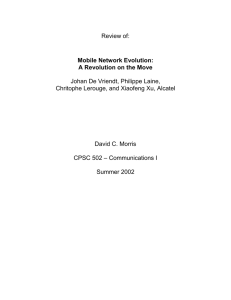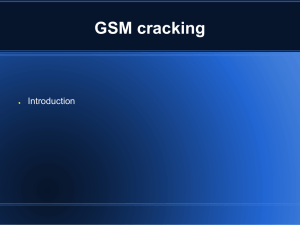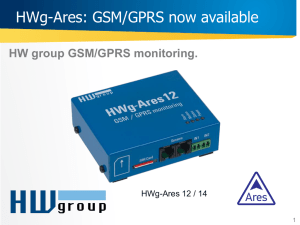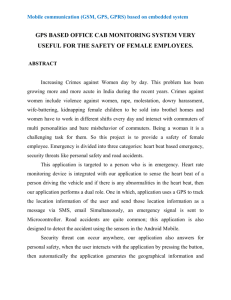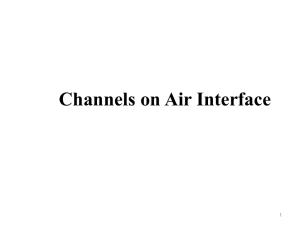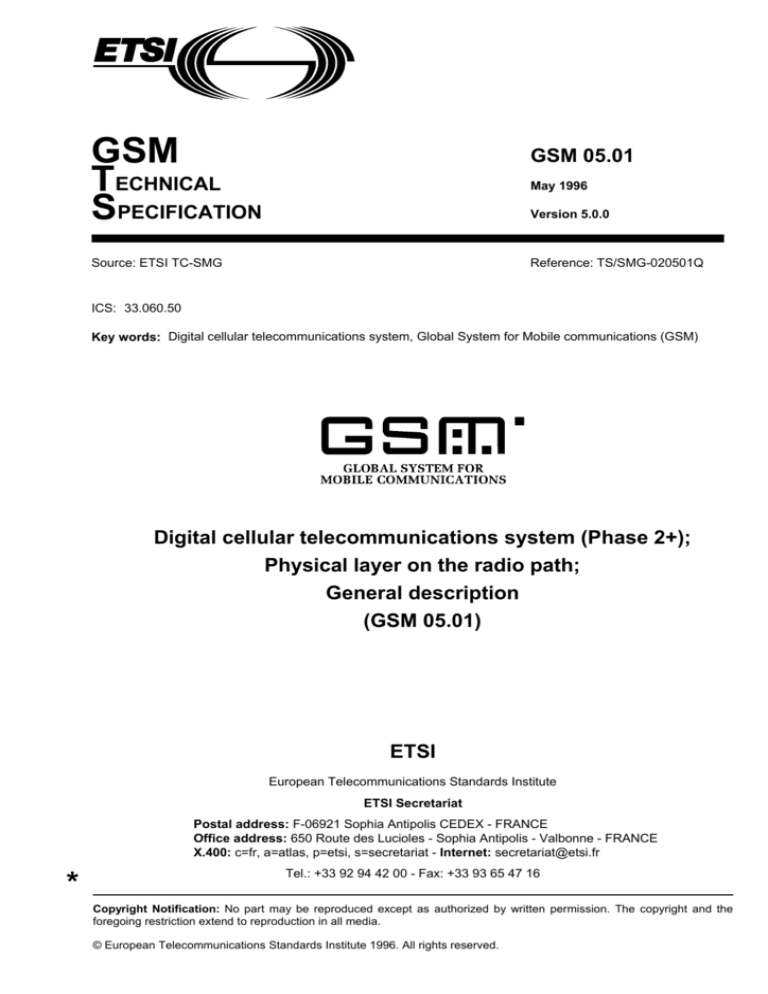
GSM
TECHNICAL
SPECIFICATION
GSM 05.01
May 1996
Version 5.0.0
Source: ETSI TC-SMG
Reference: TS/SMG-020501Q
ICS: 33.060.50
Key words: Digital cellular telecommunications system, Global System for Mobile communications (GSM)
Digital cellular telecommunications system (Phase 2+);
Physical layer on the radio path;
General description
(GSM 05.01)
ETSI
European Telecommunications Standards Institute
ETSI Secretariat
Postal address: F-06921 Sophia Antipolis CEDEX - FRANCE
Office address: 650 Route des Lucioles - Sophia Antipolis - Valbonne - FRANCE
X.400: c=fr, a=atlas, p=etsi, s=secretariat - Internet: secretariat@etsi.fr
*
Tel.: +33 92 94 42 00 - Fax: +33 93 65 47 16
Copyright Notification: No part may be reproduced except as authorized by written permission. The copyright and the
foregoing restriction extend to reproduction in all media.
© European Telecommunications Standards Institute 1996. All rights reserved.
Page 2
GSM 05.01 Version 5.0.0: May 1996
Whilst every care has been taken in the preparation and publication of this document, errors in content,
typographical or otherwise, may occur. If you have comments concerning its accuracy, please write to
"ETSI Editing and Committee Support Dept." at the address shown on the title page.
Page 3
GSM 05.01 Version 5.0.0: May 1996
Contents
Foreword .......................................................................................................................................................5
1
Scope ..................................................................................................................................................7
1.1
Normative references ..........................................................................................................7
1.2
Abbreviations .......................................................................................................................8
2
Set of channels....................................................................................................................................8
3
Reference configuration ......................................................................................................................9
4
The block structures..........................................................................................................................10
5
Multiple access and timeslot structure ..............................................................................................11
5.1
Hyperframes, superframes and multiframes .....................................................................11
5.2
Time slots and bursts.........................................................................................................11
5.3
Channel organization .........................................................................................................13
6
Frequency hopping capability............................................................................................................13
7
Coding and interleaving.....................................................................................................................15
8
Modulation.........................................................................................................................................15
9
Transmission and reception ..............................................................................................................16
10
Other layer 1 functions ......................................................................................................................17
11
Performance......................................................................................................................................17
Annex A (informative):
Reference configuration .....................................................................................18
Annex B (informative):
Relations between specification .........................................................................19
History..........................................................................................................................................................20
Page 4
GSM 05.01 Version 5.0.0: May 1996
Blank page
Page 5
GSM 05.01 Version 5.0.0: May 1996
Foreword
This Global System for Mobile communications Technical Specification (GTS) has been produced by the
Special Mobile Group (SMG) Technical Committee (TC) of the European Telecommunications Standards
Institute (ETSI).
This GTS is an introduction to the 05 series of the digital mobile cellular and personal communication
systems operating in the 900 MHz and 1800 MHz band (GSM 900 and DCS 1800).
This GTS is a TC-SMG approved GSM technical specification version 5, which contains GSM Phase 2+
enhancements/features to the version 4 GSM technical specification. The ETS from which this Phase 2+
GTS has evolved is Phase 2 GSM ETS 300 573 edition 4 (GSM 05.01 version 4.6.0).
GTS are produced by TC-SMG to enable the GSM Phase 2+ specifications to become publicly available,
prior to submission for the formal ETSI standards approval procedure to become European
Telecommunications Standards (ETS). This ensures the earliest possible access to GSM Phase 2+
specifications for all Manufacturers, Network operators and implementors of the Global System for Mobile
communications.
The contents of this GTS are subject to continuing work within TC-SMG and may change following formal
TC-SMG approval. Should TC-SMG modify the contents of this GTS it will then be republished by ETSI
with an identifying change of release date and an increase in version number as follows:
Version 5.x.y
where:
y
x
the third digit is incremented when editorial only changes have been incorporated in the
specification;
the second digit is incremented for all other types of changes, i.e. technical enhancements,
corrections, updates, etc.
The specification from which this GTS has been derived was originally based on CEPT documentation,
hence the presentation of this GTS may not be entirely in accordance with the ETSI rules.
Reference is made within this GTS to GSM-TSs (note).
NOTE:
TC-SMG has produced documents which give the technical specifications for the
implementation of the digital cellular telecommunications system. Historically, these
documents have been identified as GSM Technical Specifications (GSM-TSs). These
TSs may have subsequently become I-ETSs (Phase 1), or ETSs/ETSI Technical
Reports (ETRs) (Phase 2). TC-SMG has also produced ETSI GSM TSs which give the
technical specifications for the implementation of Phase 2+ enhancements of the
digital cellular telecommunications system. These version 5.x.x GSM Technical
Specifications may be referred to as GTSs.
Page 6
GSM 05.01 Version 5.0.0: May 1996
Blank page
Page 7
GSM 05.01 Version 5.0.0: May 1996
1
Scope
This Global System for Mobile communications Technical Specification (GTS) is an introduction to the 05
series of the GSM technical specifications for GSM and DCS 1800. It is not of a mandatory nature, but
consists of a general description of the organization of the physical layer with reference to the technical
specifications where each part is specified in detail. It introduces furthermore, the reference configuration
that will be used throughout this series of technical specifications.
1.1
Normative references
This GTS incorporates by dated and undated reference, provisions from other publications. These
normative references are cited at the appropriate places in the text and the publications are listed
hereafter. For dated references, subsequent amendments to or revisions of any of these publications
apply to this GTS only when incorporated in it by amendment or revision. For undated references, the
latest edition of the publication referred to applies.
[1]
GSM 01.04 (ETR 100): "Digital cellular telecommunication system (Phase 2);
Abbreviations and acronyms".
[2]
GSM 03.03 (ETS 300 523): "Digital cellular telecommunication system
(Phase 2); Numbering, addressing and identification".
[3]
GSM 03.20 (ETS 300 534): "Digital cellular telecommunication system
(Phase 2); Security related network functions".
[4]
GSM 03.22 (ETS 300 535): "Digital cellular telecommunication system
(Phase 2); Functions related to Mobile Station (MS) in idle mode".
[5]
GSM 04.03 (ETS 300 552): "Digital cellular telecommunication system
(Phase 2); Mobile Station - Base Station System (MS - BSS) interface Channel
structures and access capabilities".
[6]
GSM 04.08 (ETS 300 557): "Digital cellular telecommunication system
(Phase 2); Mobile radio interface layer 3 specification".
[7]
GSM 04.21 (ETS 300 562): "Digital cellular telecommunication system
(Phase 2); Rate adaption on the Mobile Station - Base Station System (MS BSS) interface ".
[8]
GSM 05.02 (ETS 300 574): "Digital cellular telecommunication system
(Phase 2); Multiplexing and multiple access on the radio path".
[9]
GSM 05.03 (ETS 300 575): "Digital cellular telecommunication system
(Phase 2); Channel coding".
[10]
GSM 05.04 (ETS 300 576): "Digital cellular telecommunication system
(Phase 2); Modulation".
[11]
GSM 05.05 (ETS 300 577): "Digital cellular telecommunication system
(Phase 2); Radio transmission and reception".
[12]
GSM 05.08 (ETS 300 578): "Digital cellular telecommunication system
(Phase 2); Radio subsystem link control".
[13]
GSM 05.10 (ETS 300 579): "Digital cellular telecommunication system
(Phase 2); Radio subsystem synchronisation".
[14]
GSM 03.30 (ETR 103): "Digital cellular telecommunication system (Phase 2);
Radio network planning aspects".
Page 8
GSM 05.01 Version 5.0.0: May 1996
1.2
Abbreviations
Abbreviations used in this GTS are listed in GSM 01.04 [1].
2
Set of channels
The radio subsystem provides a certain number of logical channels that can be separated into two
categories according to GSM 04.03 [5]:
1)
the traffic channels (TCH): they are intended to carry two types of user information streams:
encoded speech and data. Two types of traffic channels are defined: Bm or full-rate (TCH/F)
and Lm or half-rate (TCH/H) traffic channels. For the purpose of this series of technical
specifications, the following traffic channels are distinguished:
-
2)
full rate speech TCH (TCH/FS)
half rate speech TCH (TCH/HS)
9,6 kbit/s full rate data TCH (TCH/F9.6)
4,8 kbit/s full rate data TCH (TCH/F4.8)
4,8 kbit/s half rate data TCH (TCH/H4.8)
≤ 2,4 kbit/s full rate data TCH (TCH/F2.4)
≤2,4 kbit/s half rate data TCH (TCH/H2.4)
cell broadcast channel (CBCH)
the signaling channels: these can be sub-divided into BCCH (broadcast control channel),
CCCH (common control channel), SDCCH (stand-alone dedicated control channel) and
ACCH (associated control channel). An associated control channel is always allocated in
conjunction with, either a TCH, or a SDCCH. Two types of ACCH are defined: continuous
stream (slow ACCH) and burst stealing mode (fast ACCH). For the purpose of this series of
technical specifications, the following signalling channels are distinguished:
-
stand-alone dedicated control channel, four of them mapped on the same basic
physical channel as the CCCH (SDCCH/4)
stand-alone dedicated control channel, eight of them mapped on a separate basic
physical channel (SDCCH/8)
full rate fast associated control channel (FACCH/F)
half rate fast associated control channel (FACCH/H)
slow, TCH/F associated, control channel (SACCH/TF)
slow, TCH/H associated, control channel (SACCH/TH)
slow, SDCCH/4 associated, control channel (SACCH/C4)
slow, SDCCH/8 associated, control channel (SACCH/C8)
broadcast control channel (BCCH)
random access channel (ie uplink CCCH) (RACH)
paging channel (part of downlink CCCH) (PCH)
access grant channel (part of downlink CCCH) (AGCH)
notification channel (part of downlink CCCH) (NCH)
When there is no need to distinguish between different sub-categories of the same logical channel, only
the generic name will be used, meaning also all the sub-categories (SACCH will mean all categories of
SACCHs, SACCH/T will mean both the slow, TCH associated, control channels,..).
The logical channels mentioned above are mapped on physical channels that are described in this set of
technical specifications. The different physical channels provide for the transmission of information
pertaining to higher layers according to a block structure.
Page 9
GSM 05.01 Version 5.0.0: May 1996
3
Reference configuration
For the purpose of elaborating the physical layer specification, a reference configuration of the
transmission chain is used as shown in annex A. This reference configuration also indicates which parts
are dealt with in details in which technical specification. It shall be noted that only the transmission part is
specified, the receiver being specified only via the overall performance requirements. With reference to
this configuration, the technical specifications in the 05 series address the following functional units:
-
GSM 05.02: burst building, and burst multiplexing;
GSM 05.03: coding, reordering and partitioning, and interleaving;
GSM 05.04: differential encoding, and modulation;
GSM 05.05: transmitter, antenna, and receiver (overall performance).
This reference configuration defines also a number of points of vocabulary in relation to the name of bits
at different levels in the configuration. It must be outlined, in the case of the encrypted bits, that they are
named only with respect to their position after the encryption unit, and not to the fact that they pertain to a
flow of information that is actually encrypted.
Page 10
GSM 05.01 Version 5.0.0: May 1996
4
The block structures
The different block structures are described in more detail in GSM 05.03 (Channel coding). A summarised
description appears in table 1, in terms of net bit rate, length and recurrence of blocks.
Table 1: Channel block structures
Type of channel
net bit rate
(kbit/s)
block length
(bits)
block recurrence
(ms)
full rate speech TCH1
half rate speech TCH2
13,0
5,6
182 + 78
95 + 17
20
20
data TCH (9,6 kbit/s)3
data TCH (4,8 kbit/s)3
12,0
6,0
3,6
60
60
36
5
10
10
9,2
4,6
20
40
3060/13 (235)
data TCH (≤2,4 kbit/s)3
full rate FACCH (FACCH/F)
half rate FACCH (FACCH/H)
SDCCH
598/765 (≈ 0,782)
184
184
184
SACCH (with
TCH)4
115/300 (≈ 0,383)
168 + 16
480
SACCH (with
SDCCH)4
299/765 (≈ 0,391)
168 + 16
6120/13 (≈ 471)
BCCH
598/765 (≈ 0,782)
184
3060/13 (≈ 235)
AGCH5
n*598/765 (≈ 0,782)
184
3060/13 (≈ 235)
NCH5
m*598/765 (≈ 0,782)
184
3060/13 (≈ 235)
PCH5
p*598/765 (≈ 0,782)
184
3060/13 (≈ 235)
RACH5
r*26/765 (≈ 0,034)
8
3060/13 (≈ 235)
CBCH
598/765 (≈ 0,782)
184
3060/13 (≈ 235)
NOTE 1:
For full rate speech, the block is divided into two classes according to the importance of
the bits (182 bits for class I and 78 bits for class II).
NOTE 2:
For half rate speech, the block is divided into two classes according to the importance of
the bits (95 bits for class I and 17 bits for class II).
NOTE 3:
For data services, the net bit rate is the adaptation rate as defined in GSM 04.21.
NOTE 4:
On SACCH, 16 bits are reserved for control information on layer 1, and 168 bits are used
for higher layers.
NOTE 5:
CCCH channels are common to all users of a cell; the total number of blocks (m, n, p, r)
per recurrence period is adjustable on a cell by cell basis and depends upon the
parameters (BS_CC_CHANS, BS_BCCH_SDCCH_COMB, BS_AG_BLKS_RES and
NCP) broadcast on the BCCH and specified in GSM 05.02 and GSM 04.08.
Page 11
GSM 05.01 Version 5.0.0: May 1996
5
Multiple access and timeslot structure
The access scheme is Time Division Multiple Access (TDMA) with eight basic physical channels per
carrier. The carrier separation is 200 kHz. A physical channel is therefore defined as a sequence of TDMA
frames, a time slot number (modulo 8) and a frequency hopping sequence.
The basic radio resource is a time slot lasting ≈ 576,9µs (15/26 ms) and transmitting information at a
modulation rate of ≈ 270.833 kbit/s (1625/6 kbit/s). This means that the time slot duration, including guard
time, is 156,25 bit durations.
We shall describe successively the time frame structures, the time slot structures and the channel
organization. The appropriate specifications will be found in GSM 05.02 (multiplexing and multiple
access).
5.1
Hyperframes, superframes and multiframes
A diagrammatic representation of all the time frame structures is in figure 1. The longest recurrent time
period of the structure is called hyperframe and has a duration of 3h 28mn 53s 760ms (or 12533,76 s).
The TDMA frames are numbered modulo this hyperframe (TDMA frame number, or FN, from 0 to
2715647). This long period is needed to support cryptographic mechanisms defined in GSM 03.20.
One hyperframe is subdivided in 2048 superframes which have a duration of 6.12 seconds. The
superframe is the least common multiple of the time frame structures. The superframe is itself subdivided
in multiframes; two types of multiframes exist in the system:
-
a 26-frame multiframe (51 per superframe) with a duration of 120 ms, comprising 26 TDMA
frames. This multiframe is used to carry TCH (and SACCH/T) and FACCH.
a 51-frame multiframe (26 per superframe) with a duration of ≈235,4 ms (3060/13 ms),
comprising 51 TDMA frames. This multiframe is used to carry BCCH, CCCH (NCH, AGCH,
PCH and RACH) and SDCCH (and SACCH/C).
A TDMA frame, comprising eight time slots has a duration of ≈ 4,62 (60/13) ms.
5.2
Time slots and bursts
The time slot is a time interval of ≈ 576,9 µs (15/26 ms), that is 156,25 bit durations, and its physical
content is called a burst. Four different types of bursts exist in the system. A diagram of these bursts
appears in figure 1.
-
-
-
-
normal burst (NB): this burst is used to carry information on traffic and control channels,
except for RACH. It contains 116 encrypted bits and includes a guard time of 8.25 bit
durations (≈ 30,46 µs).
frequency correction burst (FB): this burst is used for frequency synchronization of the
mobile. It is equivalent to an unmodulated carrier, shifted in frequency, with the same guard
time as the normal burst. It is broadcast together with the BCCH. The repetition of FBs is also
named frequency correction channel (FCCH).
synchronization burst (SB): this burst is used for time synchronization of the mobile. It
contains a long training sequence and carries the information of the TDMA frame number
(FN) and base station identity code (BSIC, see GSM 03.03). It is broadcast together with the
frequency correction burst. The repetition of synchronization bursts is also named
synchronization channel (SCH).
access burst (AB): this burst is used for random access and is characterized by a longer
guard period (68,25 bit durations or 252 µs) to cater for burst transmission from a mobile
which does not know the timing advance at the first access (or after handover).This allows for
a distance of 35 km. In exceptional cases of cell radii larger than 35 km, some possible
measures are described in GSM 03.30. The access burst is used in the RACH and after
handover, as well as on the uplink of a channel used for a voice group call in order to request
the use of that uplink.
Page 12
GSM 05.01 Version 5.0.0: May 1996
Figure 1: Time frames time slots and bursts
Page 13
GSM 05.01 Version 5.0.0: May 1996
5.3
Channel organization
The channel organization for the traffic channels (TCH), FACCHs and SACCH/T uses the 26-frame
multiframe. It is organized as described in figure 2, where only one time slot per TDMA frame is
considered.
(a)
T
T
T
T
T
T
T
T
T
T
T
T
A
T
T
T
T
T
T
T
T
T
T
T
T
-
T
t
T
t
T
t
T
t
T
t
a
26 frames = 120 ms
(b)
T
t
T
t
T
t
T
t
T
t
T
t
A
T
(a) case of one full rate TCH
T, t: TDMA frame for TCH
t
(b) case of two half rate TCHs
-: idle TDMA frame
A, a: TDMA frame for SACCH/T
Figure 2: Traffic channel organization
The FACCH is transmitted by preempting half or all of the information bits of the bursts of the TCH to
which it is associated (see GSM 05.03).
The channel organization for the control channels (except FACCHs and SACCH/T) uses the 51-frame
multiframe. It is organized in the downlink and uplink as described in figure 3.
6
Frequency hopping capability
The frequency hopping capability is optionally used by the network operator on all or part of its network.
The main advantage of this feature is to provide diversity on one transmission link (especially to increase
the efficiency of coding and interleaving for slowly moving mobile stations) and also to average the quality
on all the communications through interferers diversity. It is implemented on all mobile stations.
The principle of slow frequency hopping is that every mobile transmits its time slots according to a
sequence of frequencies that it derives from an algorithm. The frequency hopping occurs between time
slots and, therefore, a mobile station transmits (or receives) on a fixed frequency during one time slot
(≈ 577 µs) and then must hop before the time slot on the next TDMA frame. Due to the time needed for
monitoring other base stations the time allowed for hopping is approximately 1 ms, according to the
receiver implementation. The receive and transmit frequencies are always duplex frequencies.
The frequency hopping sequences are orthogonal inside one cell (ie no collisions occur between
communications of the same cell), and independent from one cell to an homolog cell (ie using the same
set of RF channels, or cell allocation). The hopping sequence is derived by the mobile from parameters
broadcast at the channel assignment, namely, the mobile allocation (set of frequencies on which to hop),
the hopping sequence number of the cell (which allows different sequences on homolog cells) and the
index offset (to distinguish the different mobiles of the cell using the same mobile allocation). The nonhopping case is included in the algorithm as a special case. The different parameters needed and the
algorithm are specified in GSM 05.02.
In case of multi band opertaion frequency hopping channels in different bands of opertaion, e.g. between
channels in GSM and DCS, is not supported. Frequency hopping within each of the bands supported shall
be implemented in the mobile station.
It must be noted that the basic physical channel supporting the BCCH does not hop.
Page 14
GSM 05.01 Version 5.0.0: May 1996
Figure 3: Channel organization in the 51-frame multiframe
Page 15
GSM 05.01 Version 5.0.0: May 1996
7
Coding and interleaving
A brief description of the coding schemes that are used for the logical channels mentioned in section 2,
plus the synchronization channel (SCH, see 5.2), is made in the following table. For all the types of
channels the following operations are made in this order:
-
external coding (block coding);
internal coding (convolutional coding);
interleaving.
After coding the different channels (except RACH and SCH) are constituted by blocks of coded
information bits plus coded header (the purpose of the header is to distinguish between TCH and FACCH
blocks). These blocks are interleaved over a number of bursts. The block size and interleaving depth are
channel dependent. All these operations are specified in GSM 05.03.
Type of channel
TCH/FS
class I2
class II
TCH/HS
class I3
class II
8
bits/block
data+parity+tail1
convolutional
code rate
182 + 3 + 4
78 + 0 + 0
1/2
-
coded bits per
block
456
378
78
228
211
17
interleaving
depth
8
4
95+3+6
17+0+0
104/211
TCH/F9.6
TCH/F4.8
TCH/H4.8
TCH/F2.4
TCH/H2.4
4*60 + 0 + 4
60 + 0 + 16
4*60 + 0 + 4
72 + 0 + 4
72 + 0 + 4
244/456
1/3
244/456
1/6
1/3
456
228
456
456
228
19
19
19
8
19
FACCH/F
FACCH/H
SDCCHs
SACCHs
BCCH NCH AGCH
PCH
CBCH
RACH
SCH
184 + 40 + 4
184 + 40 + 4
1/2
1/2
456
456
8
6
184 + 40 + 4
8+ 6+ 4
25 + 10 + 4
1/2
1/2
1/2
456
36
78
4
1
1
NOTE 1:
The tail bits mentioned here are the tail bits of the convolutional code.
NOTE 2:
The 3 parity bits for TCH/FS detect an error on 50 bits of class I.
NOTE 3:
The 3 parity bits for TCH/HS detect an error on 22 bits of class I.
Modulation
The modulation scheme is gaussian MSK (GMSK) with BT = 0,3. As already mentioned the modulation
rate is 1625/6 kbit/s (≈ 270,83 kbit/s). This scheme is specified in detail in GSM 05.04 (Modulation and
demodulation).
Page 16
GSM 05.01 Version 5.0.0: May 1996
9
Transmission and reception
The modulated stream is then transmitted on a radio frequency carrier. The frequency bands and channel
arrangement are the following.
i)
Standard or primary GSM 900 Band, P-GSM;
For Standard GSM 900 Band, the system is required to operate in the following frequency band:
890 - 915 Mhz: mobile transmit, base receive
935 - 960 Mhz: base transmit, mobile receive
ii)
Extended GSM 900 Band, E-GSM (includes Standard GSM 900 band);
For Extended GSM 900 Band, the system is required to opertate in the following frequency band:
880 - 915 Mhz: mobile transmit, base receive
925 - 960 Mhz: base transmit, mobile receive
iii)
DCS 1800 Band
For DCS 1800, the system is required to operate in the following frequency band:
1710 - 1785 Mhz: mobile transmit, base receive
1805 - 1880 Mhz: base transmit, mobile receive
NOTE:
The term GSM 900 is used for any GSM system which operates in any 900 Mhz band.
Operators may implement networks on a combination of the frequency bands above to support multi band
mobile stations which are defined in GSM 02.06.
The RF channel spacing is 200 kHz, allowing for 174 (GSM 900) and 374 (DCS 1800) radio frequency
channels, thus leaving a guard band of 200 kHz at each end of the subbands.
The specific RF channels, together with the requirements on the transmitter and the receiver will be found
in GSM 05.05 (Transmission and reception).
In order to allow for low power consumption for different categories of mobiles (eg. vehicle mounted,
hand-held, ..), different power classes have been defined. For GSM 900 there are four power classes with
the maximum power class having 8 W peak output power (ca 1 W mean output power) and the minimum
having 0,8 W peak output power. For DCS 1800 there are three power classes of 4 W peak output power,
1 W peak output power (ca 0.125 W mean) and 0.25 W peak output power.
Multi band mobile stations may have any combinations of the allowed power classes for each of the bands
supported.
The power classes are specified in GSM 05.05.
The requirements on the overall transmission quality together with the measurement conditions are also in
GSM 05.05.
Page 17
GSM 05.01 Version 5.0.0: May 1996
10
Other layer 1 functions
The transmission involves other functions. These functions may necessitate the handling of specific
protocols between BS and MS. Relevant topics for these cases are:
11
1)
the power control mechanisms which adjust the output level of the mobile station (and
optionally of the base station) in order to ensure that the required quality is achieved with the
less possible radiated power. Power levels with 2 dB steps have been defined for that
purpose. This is described in GSM 05.08 (radio subsystem link control) and GSM 05.05.
2)
the synchronization of the receiver with regard to frequency and time (time acquisition and
time frame alignment). The synchronization problems are described in GSM 05.10
(synchronization aspects).
3)
the hand-over and quality monitoring which are necessary to allow a mobile to continue a call
during a change of physical channel. This can occur either because of degradation of the
quality of the current serving channel, or because of the availability of another channel which
can allow communication at a lower Tx power level, or to prevent a MS from grossly
exceeding the planned cell boundaries. In the case of duplex point-to-point connections, the
choice of the new channel is done by the network (base station control and MSC) based on
measurements (on its own and on adjacent base stations) that are sent on a continuous
basis by the mobile station via the SACCHs. The requirements are specified in GSM 05.08
(radio subsystem link control).
4)
the measurements and sub-procedures used in the first selection or reselection of a base
station by a mobile are specified in GSM 05.08 (radio subsystem link control). (The overall
selection and reselection procedures, together with the idle mode activities of a mobile are
defined in GSM 03.22 (functions related to MS in idle mode).)
5)
the measurements and sub-procedures used by an MS in selecting a base station for
reception of a voice group or a voice broadcast call are specified in GSM 05.08 (radio
subsystem link control). The overall voice group and voice broadcast cell change procedures,
being similar to the reselection procedures related to the idle mode activities of an MS, are
defined in GSM 03.22 (functions related to MS in idle mode).
Performance
Under typical urban fading conditions (ie multipath delays no greater than 5 µs), the quality threshold for
full-rate speech is reached at a C/I value of approximately 9 dB. The maximum sensitivity is approximately
-104 dBm for base stations and GSM mobiles and -102 dBm and -100 dBm for GSM 900 small MSs (see
GSM 05.05) and DCS 1800 hand-helds, respectively.
Multi band mobile stations shall meet the reqirements on each band of operation respectively.
Page 18
GSM 05.01 Version 5.0.0: May 1996
Annex A (informative):
Reference configuration
Page 19
GSM 05.01 Version 5.0.0: May 1996
Annex B (informative):
Relations between specification
Page 20
GSM 05.01 Version 5.0.0: May 1996
History
Document history
April 1996
Creation of Version 5.0.0 (CRs A007.A018, A019, A020)
May 1996
Publication of Version 5.0.0
ISBN 2-7437-0712-7
Dépôt légal : Mai 1996


